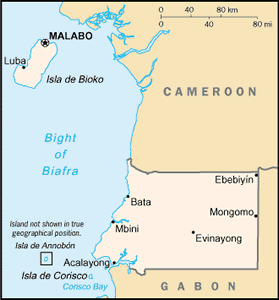The Geography of Equatorial Guinea
The Geography of Equatorial Guinea
Equatorial Guinean or Equatoguin Geography
Location: Western Africa, bordering the Bight of Biafra, between Cameroon and Gabon
Geographic coordinates: 2 00 N, 10 00 E
Map references: Africa
Area: total: 28,051 sq km land: 28,051 sq km water: 0 sq km
Area - comparative: slightly smaller than Maryland
Land boundaries: total: 539 km border countries: Cameroon 189 km, Gabon 350 km
Coastline: 296 km
Maritime claims: territorial sea: 12 nm exclusive economic zone: 200 nm
Climate: tropical; always hot, humid
Terrain: coastal plains rise to interior hills; islands are volcanic
Elevation extremes: lowest point: Atlantic Ocean 0 m highest point: Pico Basile 3,008 m
Natural resources: petroleum, natural gas, timber, gold, bauxite, diamonds, tantalum, sand and gravel, clay
Land use: arable land: 4.63% permanent crops: 3.57% other: 91.8% (2005)
Irrigated land: NA
Natural hazards: violent windstorms; flash floods
Environment - current issues: tap water is not potable; deforestation
Environment - international agreements: party to: Biodiversity, Climate Change, Climate Change-Kyoto Protocol, Desertification, Endangered Species, Hazardous Wastes, Law of the Sea, Marine Dumping, Ozone Layer Protection, Ship Pollution, Wetlands signed, but not ratified: none of the selected agreements
Geography - note: insular and continental regions widely separated


